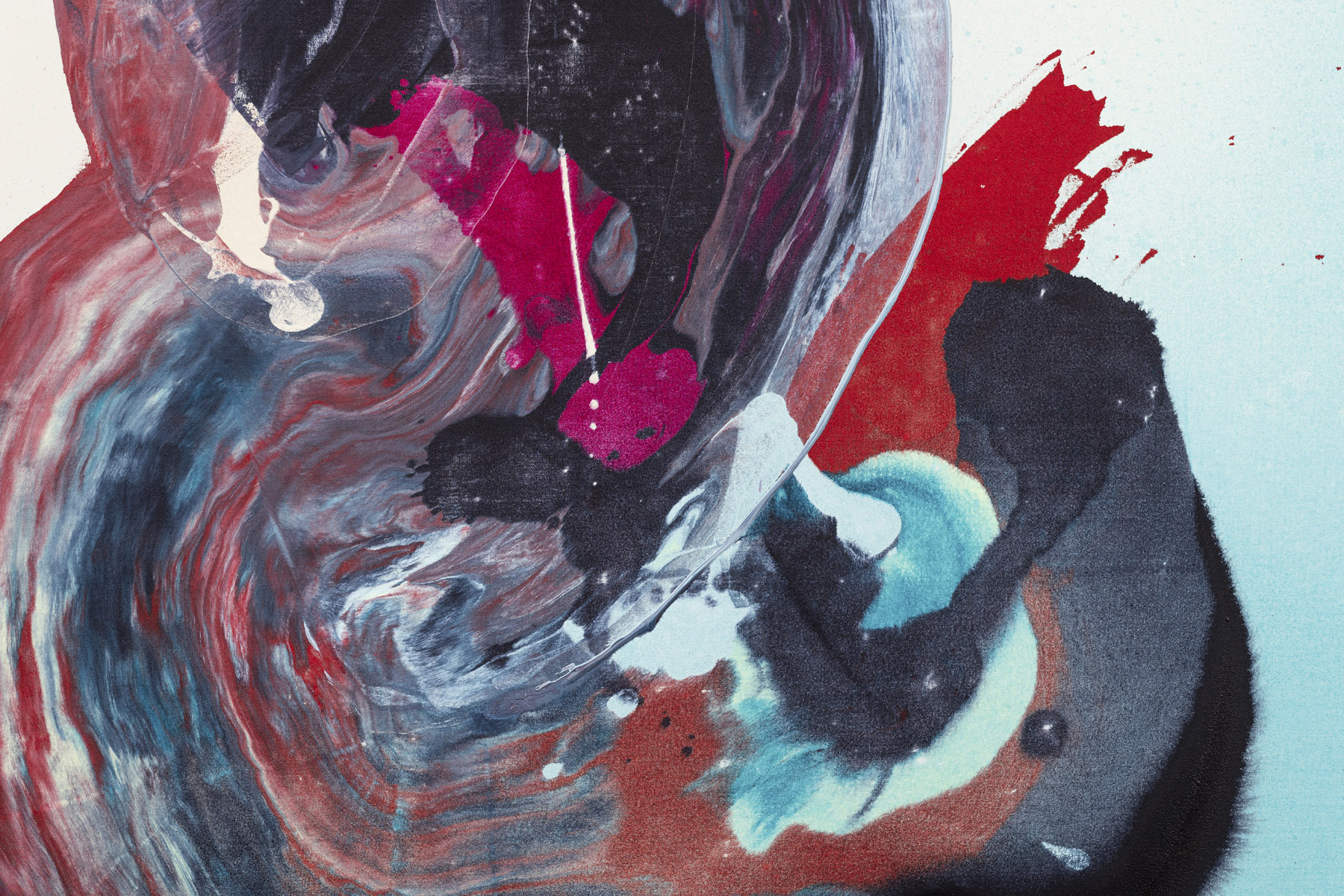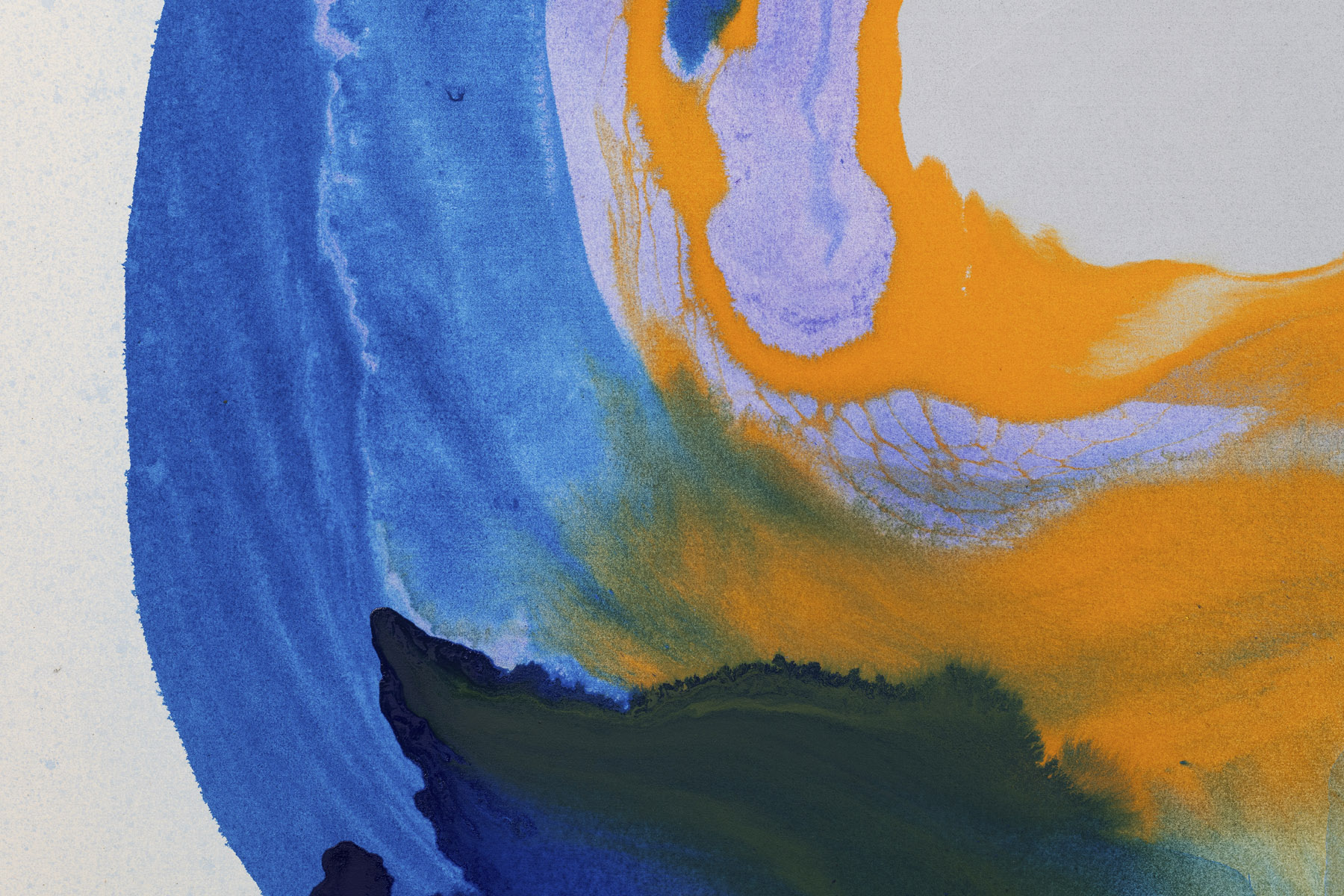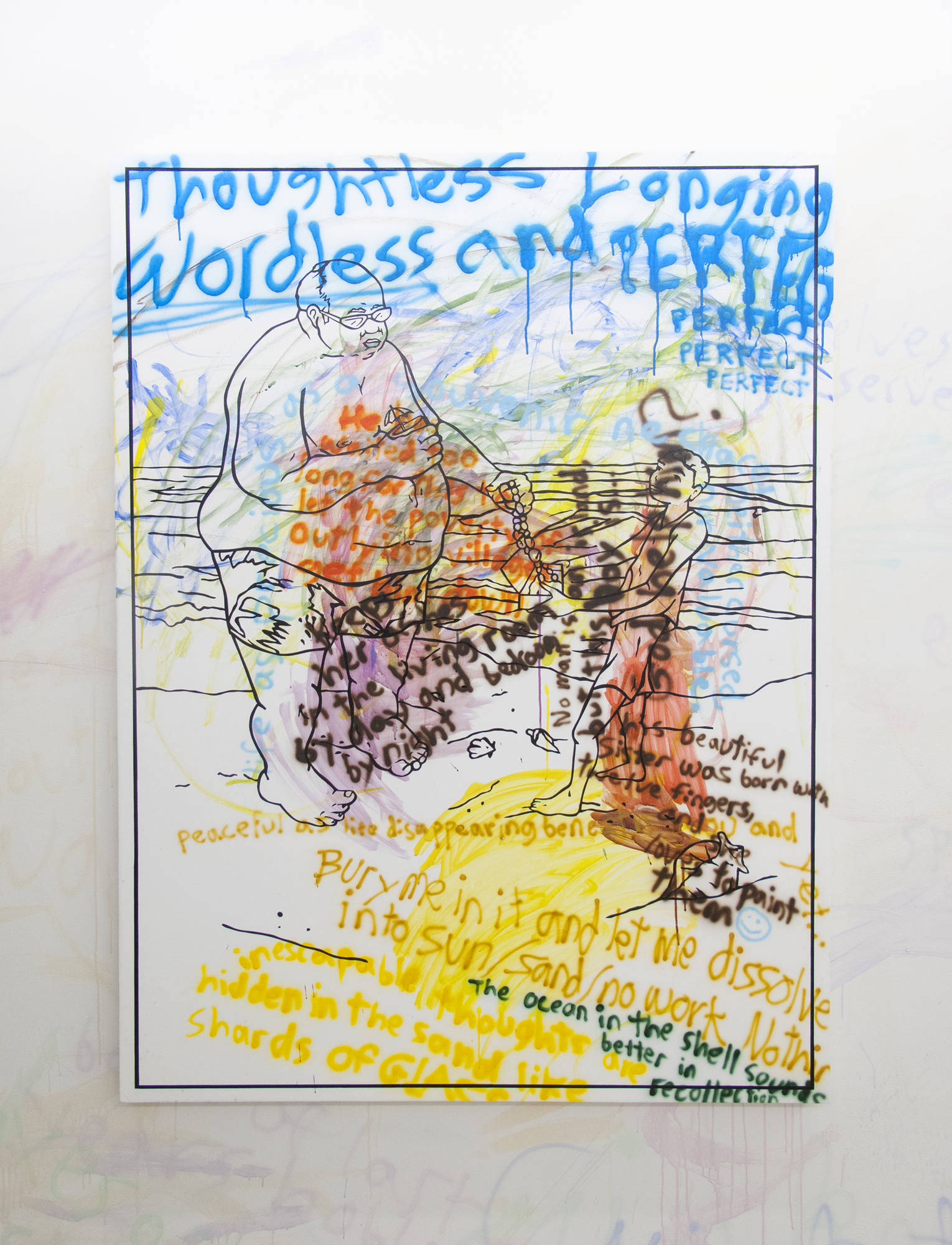Artist: Ragna Bley
Exhibition title: Soundings
Venue: Tara Downs, New York, US
Date: January 21 – March 6, 2021
Photography: all images copyright and courtesy of the artist and Tara Downs, New York
In his 1985 novel Galápagos, American author Kurt Vonnegut envisions human life one million years into the future. After a virus renders humanity infertile in the late 20th century, mankind is perpetuated by a small group of tourists shipwrecked on the Galapágos Islands, where their descendants evolve into furry, sea-lion-like creatures, sprouting flippers, beaks and diminished brains. Driven by the hard rules of natural selection, human beings have returned to the sea.
The Hungarian Nobel Prize winner Albert Szent-Györgyi refers to water as the mater and matrix: the mother and womb of life. To return to water is, to cast a Freudian light on things, to return to the womb from which we came, where all our needs were met: a primal existence unfettered by social relations and their consequences. In a less anthropocentric view, Vonnegut’s vision admits to the non-exceptional role of human beings in the vast network of lifeforms inhabiting the planet. Our origin in the sea unites every being, humans and microorganisms alike.
In Ragna Bley’s paintings, water is everywhere. It is one reason her works seem to be so animated, alive. In her newest series, the artist’s keen interests in marine biology intermarry with her taste for the fan-tastical – presenting visual mediations that squish the distance between the glittering ocean surface and the secrets of its vast depths. Thinned-out acrylic paint swirls and seeps across the canvases, with strips and overlapping fields of lambent color glowing like jewels on the ocean floor in one painting only to ooze forth as primordial soup in the next. In Pile, a rainbow of seaweed greens and magenta pinks hugs pale shades of greenish blues and dirty yellows; a potentially heady combination, yet the picture seems to float aloft, carried by the layered brilliance of the paint. In Evening, Pom-pom, writhing columns of black, blue, yellow, and pink erupt from a delicate pastel plinth like an underwater volcano, suggesting perfect poise between explosive energy and complete tranquility.
However much the paint in Bley’s works appears to be in motion, it hardly ever drips. The paintings are completed on the floor of the artist’s studio following a process of sketching and careful color selection in smaller formats. The canvases, resting larger than their finished, stretched selves, are primed before the first layer of paint is applied – often a semi-transparent shape that serves as the paintings’ ground – ing, while subsequent layers are sprayed or poured onto the tightly-woven sailcloth. The paint is then dragged, distributed and shaped by the artist’s spatulas, rulers, brushes or, sometimes, her own hands.
Horizontality has, in the context of modern painting, and especially through Rosalind Krauss’ 1997 essay “Horizontality,” been linked to a kind of “base” attack on “civilized” verticality. Yet the horizontal plane doesn’t just suggest an artist working at ground level, on all fours, close to the dirt. It also connotes water, whose surface is the very definition of horizontality – the theoretical line of the true horizon is the meeting point between the sky and the sea. The physical laws of water are visibly at work in Bley’s paintings: in Circadian, a patch of crimson bleeds into underlying fields of ochre and pink, not unlike, in appearance, the red tides created by algal blooms near the oceanic surface. Its spikes belie the painting’s vertical mounting and bear witness to a horizontal conception, while similar spillages can be seen across Soundings. Indeed, they are a well-established signature in Bley’s work – already a defining feature in the two series of large-scale paintings the artist created for her 2020 solo exhibition at Malmö Konsthall.
While visually reminiscent of watercolor pigments, the technique was pioneered by Helen Frankenthal-er in the 1950s, in the artist’s soak-stained paintings. Like Frankenthaler, Ragna Bley is a highly skilled manipulator of paint, yet by allowing her pigments to act in large accordance with their will, Bley foregoes the claim of complete command over the finished product – a subtle undercutting, one could argue, of the egocentric, male genealogy of much modernist art. In a similar vein, visible brushstrokes, the highly charged “the artist-is-present” of a painting, are more or less erased from the smooth surfaces of the can – vases. In previous parts of her oeuvre, the artist’s willingness to submit her works to external forces has ample precedent: both in her 2016 installation for the UKS gallery in Oslo, and in her ANNO series for Malmö Konsthall, where pockets of natural colorants were sewn into several canvases mounted under the open sky and subject to wet Scandinavian weather. In Soundings, the gesture is more subdued, yet the paintings nonetheless stage a dissolution of human agency – arguably a dilution in itself – in the meeting between paint and water.
*
The ocean’s surface is there for anyone to see; nevertheless, its depths, remain largely inaccessible other than by a remote sensing, or “sounding.” The ocean’s photic or sunlit zone runs between one and two hundred meters deep and is home to ninety percent of marine life. Below, lies the darker dysphotic or twilight zone, subjacent to which is the pitch-blackness of the bottom layer: the apothic or midnight zone, sometimes referred to as the dark ocean. This, like Vonnegut’s fictional universe in Galápagos, is a realm ruled by the hard logic of evolution and extreme adaptability, where strange species of deep-sea fish and giant squids glide through the waters seeking prey or partners using ingenious methods to compensate for the lack of light.
Ragna Bley, attuned to scientific journals and science-fiction alike, has in recent years introduced a series of organic shapes to her compositions, reminiscent of, but not reducible to, otherworldly creatures of the sea, ancient aquatic life forms and parasitic microorganisms. Neither pure shape nor drawn from life, the figures blur the line between abstraction and figuration. The large, multiarmed outline that hovers in the middle of a rich purple color field in Hurled Life looks distinctly like something – a fossil? a microbe?
Impossible to pin down, it’s hard not to think the scale is somehow off, that it’s something tiny presented as something vast, sublime. In Vocal Low, orange and blue cylinders climb from a mossy green under-growth, like worms or bacteria in a petri dish or the sinuous tentacles of some as yet unfathomed biolu-minescent squid. There’s no one way to read these shapes and outlines, nor are the marine associations the only ones available for Bley’s paintings. Viewing the works in Soundings through such a lens allows one to see her sprawling universe of vibrant colors and fantastical forms as considerations on the deepest foundations of all living things, as well as on phenomena on the very outskirts of human reach. Rather than intimidated by a dark and unreachable beyond, Bley surfaces its secrets – pushing them to ripple and unfold.
— Maria Horvei
Ragna Bley (b. 1986, Uppsala, Sweden) lives and works in Oslo, Norway. She received her BFA at the Na-tional Academy of Fine Arts, Oslo, in 2011 and her MA in Painting from the Royal College of Art, London in 2015. Solo and two-person presentations include Downs & Ross, New York; Malmö Konsthall, Malmö; OSL Contemporary, Olso; Kunsthuset Kabuso, Øystese; Kunsthall Oslo, Oslo; The Munch Museum, Oslo; Downs & Ross at the Armory Show, New York; Frankfurt am Main, Berlin; and Hester, New York. Select-ed group exhibitions include: Moderna Museet, Stockholm; Kistefosmuseet, Jevnaker; F15, Moss; Rupert, Vilnius; the Norwegian Sculpture Biennial, Oslo; Editorial, Vilnius; UKS, Oslo; Museum of Applied Arts, Vilnius; Bosse & Baum, London; Royal College of Art, London; 1857, Oslo; Taiga Art Space, St. Peters-burg, and Kunstnernes Hus, Oslo. Her work has been the subject of extensive coverage in publications including Artnews, Artsy, Blouin Artinfo, Flash Art, Frieze Magazine, Klassekampen, Morgenbladet, Dagens Nyheter, Svenska Dagbladet, Triple Canopy, and Wallpaper, among numerous others. Her work is included in the permanent collections of the National Museum, Oslo; Moderna Museet, Stockholm; Kistefosmuseet, Jevnaker; and Malmö Konstmueum, Malmö.
Exhibition View, Ragna Bley: Soundings, 2021, Downs & Ross, New York, Courtesy of the artist and Downs & Ross, New York, Photo: Daniel Terna
Ragna Bley, Undertow (Heat), 2020, Acrylic on sailcloth, 59 × 37 1/2 inches / 150 × 95 cm, Courtesy of the artist and Downs & Ross, New York, Photo: Daniel Terna
Ragna Bley, Witnesses, 2020, Acrylic on sailcloth, 59 × 69 inches / 150 × 175 cm, Courtesy of the artist and Downs & Ross, New York, Photo: Daniel Terna
Ragna Bley, Witnesses, 2020 (installation view), Acrylic on sailcloth, 59 × 69 inches / 150 × 175 cm, Courtesy of the artist and Downs & Ross, New York, Photo: Daniel Terna
Exhibition View, Ragna Bley: Soundings, 2021, Downs & Ross, New York, Courtesy of the artist and Downs & Ross, New York, Photo: Daniel Terna
Ragna Bley, Pile, 2020, Acrylic on sailcloth, 59 × 37 1/2 inches / 150 × 95 cm, Courtesy of the artist and Downs & Ross, New York, Photo: Daniel Terna
Ragna Bley, Pile, 2020 (detail), Acrylic on sailcloth, 59 × 37 1/2 inches / 150 × 95 cm, Courtesy of the artist and Downs & Ross, New York, Photo: Istvan Virag
Exhibition View, Ragna Bley: Soundings, 2021, Downs & Ross, New York, Courtesy of the artist and Downs & Ross, New York, Photo: Daniel Terna
Ragna Bley, Hurled Life, 2020, Acrylic on sailcloth, 59 × 94 1/2 inches / 150 × 260 cm, Courtesy of the artist and Downs & Ross, New York, Photo: Daniel Terna
Ragna Bley, Hurled Life, 2020 (detail), Acrylic on sailcloth, 59 × 94 1/2 inches / 150 × 260 cm, Courtesy of the artist and Downs & Ross, New York, Photo: Daniel Terna
Ragna Bley, Hurled Life, 2020 (installation view), Acrylic on sailcloth, 59 × 94 1/2 inches / 150 × 260 cm, Courtesy of the artist and Downs & Ross, New York, Photo: Daniel Terna
Ragna Bley, Circadian, 2020, Acrylic on sailcloth, 59 × 37 1/2 inches / 150 × 95 cm, Courtesy of the artist and Downs & Ross, New York, Photo: Daniel Terna
Exhibition View, Ragna Bley: Soundings, 2021, Downs & Ross, New York, Courtesy of the artist and Downs & Ross, New York, Photo: Daniel Terna
Ragna Bley, Whole Current, 2020, Acrylic on sailcloth, 59 × 37 1/2 inches / 150 × 95 cm, Courtesy of the artist and Downs & Ross, New York, Photo: Daniel Terna
Ragna Bley, Whole Current, 2020, Acrylic on sailcloth, 59 × 37 1/2 inches / 150 × 95 cm, Courtesy of the artist and Downs & Ross, New York, Photo: Istvan Virag
Exhibition View, Ragna Bley: Soundings, 2021, Downs & Ross, New York, Courtesy of the artist and Downs & Ross, New York, Photo: Daniel Terna
Ragna Bley, Salt Tracks, 2020, Acrylic on sailcloth, 59 × 37 1/2 inches / 150 × 95 cm, Courtesy of the artist and Downs & Ross, New York, Photo: Daniel Terna
Ragna Bley, Čir-čir, Audra, 2020, Acrylic on sailcloth, 59 × 37 1/2 inches / 150 × 95 cm, Courtesy of the artist and Downs & Ross, New York, Photo: Daniel Terna
Ragna Bley, Čir-čir, Audra, 2020, Acrylic on sailcloth, 59 × 37 1/2 inches / 150 × 95 cm, Courtesy of the artist and Downs & Ross, New York, Photo: Istvan Virag
Exhibition View, Ragna Bley: Soundings, 2021, Downs & Ross, New York, Courtesy of the artist and Downs & Ross, New York, Photo: Daniel Terna
Ragna Bley, Synchrone, 2020, Acrylic on sailcloth, 59 × 37 1/2 inches / 150 × 95 cm, Courtesy of the artist and Downs & Ross, New York, Photo: Daniel Terna
Exhibition View, Ragna Bley: Soundings, 2021, Downs & Ross, New York, Courtesy of the artist and Downs & Ross, New York, Photo: Daniel Terna
Ragna Bley, Level Plains, 2020, Acrylic on sailcloth, 59 × 37 1/2 inches / 150 × 95 cm, Courtesy of the artist and Downs & Ross, New York, Photo: Daniel Terna





























